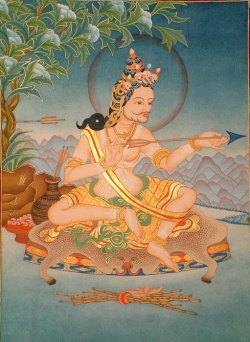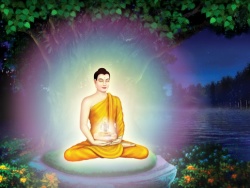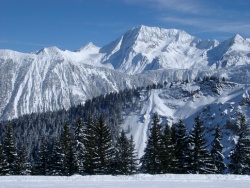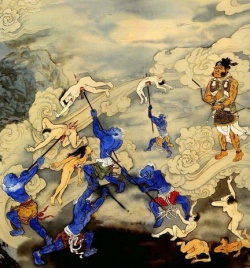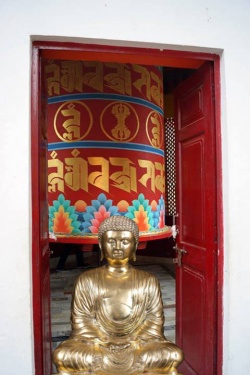Rosary of White Lotuses
Rosary of White Lotuses
A Brief Examination of Two Figures in Rosary of White Lotuses,
Being the Clear Account of How the Precious Teaching of Buddha Appeared and Spread in the Great Hor Country
Nathan Bates
Abstract: Damcho Gyatso Dharmatāla (Dam-chos rGya-mtsho Dharma-ta-la) wrote Rosary of White Lotuses, Being the Clear Account of How the Precious Teaching of Buddha Appeared and Spread in the Great Hor Country in the 1880s in order to tell the history of Buddhism’s spread into Inner and Outer Mongolia (Hor). Rosary of White Lotuses is a collection of short biographies that explain how Buddhist ideas moved from place to place, and its focus is broad. Dharmatala begins with a discussion of Siddhartha Gautama’s birth and ending in the Qing period. I have focused on two figures. As a result I have chosen to use the actions of Huthogthu Tāranātha Jetsun Dampa Rinpoche Lobzang Tenpé Gyentsen (Hu-thog-thu Tā-ra-nā-tha Rje-btsun Dam-pa rin-po-che Blo-bzang bstan-pa’i rgyal-mtshan dpal bzang-po) (1635 - 1723) and Neichi Thoyon Huthogthu Lama Rinpoche (Mkhar sngon Tho-yon Hu-thog-thu Bla-ma Rin-po-che) (1557 – 1653) as a lens for understanding Dhramtāla’s discussion of the imminent Mongol teachers that were key to spread of Buddhism in Sog.
Damcho Gyatso Dharmatāla’s Rosary of White Lotuses: Being the Clear Account of How the Precious Teaching of Buddha Appeared and Spread in the Great Hor Country[1] tells of the movement of Tibetan Buddhism into Hor, or Mongolia. Rather than providing a purely historiographic account of Buddhism’s spread through Hor, Dharmatāla’s account is a genealogy of the lamas whose actions spread the Teachings of Buddha throughout the region. As a result, the Rosary of White Lotuses is as much a work of biography as it is a historical account. Dhramatāla’s work covers a great span of history, beginning with the miraculous birth of the First Buddha, Siddhartha Gautama, and ending during the eighteenth century. Due to this incredible span, and the many individuals that this work discusses, I will be focusing my summary on the native Mongol lamas that were active in both Inner and Outer Mongolia.
In Rosary of White Lotus’ first description of Hor[2], Dhramatāla describes the people that populate these regions, and it is important that his description of those people that populate High Hor, or Inner and Outer Mongolia, and Kokonor, Dharmatāla explains that "…There are no infidels and barbarians there ( = Hor), nor is there (even) a trace of wrong doctrines. The former Dharma lineages of Sakyapa and Karmapa are not continued there nowadays, either, and everyone follows the only and only system of the Yellow Hats" (Dharmatāla 46). This description of the importance of the Gelug (dge-lugs-pa) sect is important because it shows that Dharmatāla has fallen prey to the Gelugpa sense of superiority[3]; however, it is true that the importance of the Gelugpa, beginning with the Third Dalai Lama, among the Mongols cannot be understated. As such, all of the “great” Mongol lamas that he discusses are members of the Gelug sect.
Dharmatāla’s historiography describes the lives and actions of several major lamas and their disciples, in addition to some less influential lamas. Two of most noteworthy lamas described in Rosary of White Lotuses are Huthogthu Tāranātha Jetsun Dampa Rinpoche Lobzang Tenpé Gyentsen and Neichi Thoyon Huthogthu Lama Rinpoche. These two biographies not only provide an excellent lens for understanding what attributes provided a lama with the most merit, they also represent two very different approaches.
Huthogthu Tāranātha Jetsun Dampa Rinpoche Lobzang Tenpé Gyentsen represents the first of these approaches, the monastic approach to spreading Buddhism. Because Lobzang Tenpé Gyentsen was the First Jetsun Dhampa, his biography includes a brief genealogy of his pre-incarnate lives, and these lives provide him with both religious and historical legitimacy. Of those lives, the most significant is Jamyang Chojé Tashi Palden (‘Jam-dbyangs Chos-rje bKra-shis dPal-ldan), who is referred to as “the best 'son' of Tsong Khapa (337).” This connection to Tsong Khapa is important, because Lobzang Tenpé Gyentsen is credited with “spread[ing] the Teaching unto the land’s most remote reaches (337),” a goal that could only be accomplished by the “clarification of the Buddha’s Teaching” was facilitated by the spread of the “faultless teachings of the Second Buddha (= Tsong Khapa)” (370). Because Lobzang can remember being Tashi Palden, one of Tsongkhapa’s closest students, he possesses a unique authority to spread the teachings of the Gelugpa founder.
In addition to drawing his reader’s attention to Gyentsen’s auspicious genealogy Dharmatāla describes him as being an especially gifted child that would “recite Mañjuśri Nama Sangiti twice a day despite having never learned it” (338). This combination of spiritual heritage and exceptional attributes culminated in Gyentsen joining the Sera monastery in 1650, at the age of 15. Just a year later, he was tasked with founding new monasteries by the Panchen Rinpoche in his homeland—Sog Country (338).
From 1654 until his death in 1723 Gyentshen accumulated many disciples, founded two new Gelugpa temples, called Riwo Gergyé Ganden Shedrup Ling and Riwo Gergyé Ling (338, 343), and restored the Erteni Jowo temple, which was built by one of his temporal forebears, king Ochir Opatai (337). He also founded two colleges within the Riwo Gergya Ling (343), authored several books, and translated the Karandha Dictionary into the Sog language.
The second major figure that Dharmatāla discusses is Neichi Thoyon Huthogthu Lama Rinpoche. Unlike Gyentsen, Neichi Thoyon was not a member of an incarnation lineage. Instead, Rosary of White Lotuses provides the reader with only a little information on Thoyon’s background, namely that he was a noble who, like Siddartha, spent his life working for the benefit others. It was this drive that resulted in the First Panchen Lama sending Thoyon to the northern lands of Hor (352).
During this time, Thoyon devoted thirty-five years to the study of the “four divisions of yoga” after which he had accumulated many powers, including the ability to prophesize and the ability to conduct two kinds of miracles (353). By enumerating these mystical abilities Thoyon is provided with the religious legitimacy that figures such as Gyentshen gain through their incarnations. By using Thoyon’s wisdom and ability as a legitimizing force, those disciples and converts that he bestows empowerments and initiations upon were able to gain some legitimacy of their own through their relationship with him. Yet, despite Thoyon’s impressive personal accomplishments, Dharmatāla spends precious little time describing this important lama, again, choosing to focus on his accumulation of disciples through the dual efforts of evangelization and literary creation and translation. Because of the emphasis that Dhramatāla places on Thoyon’s effort to gain new disciples, Thoyon’s approach to spreading the Teaching is evangelization. This approach strongly contrasts with Gyentshen’s monastic or scholarly approach in one major way: the volume and variety of people affected by Thoyon. As a result of the vast amount people and areas effected by his teaching, the Fifth Dalai Lama recognized him as the “essence of perfection of the great Tsong Khapa’s teachings” (359).
The great majority of the remaining figures that are described in Rosary of White Lotuses fit within the framework of these two approaches that are embodied by these figures, what I call the monastic and evangelist approaches. Yet despites these different approaches to spreading both Buddha and Tsongkhapa’s Teachings, it is important to remember that all of these figures also have one very important thing in common, their role in creating and translating Buddhist works in the Sog language. As Dhramatāla points out in his summary of the Mongols’ role in spreading the Teaching throughout Hor, the success of the success of this endeavor was largely the result of “the clarification of the Buddha’s Teaching [through] the new books of teachings which were composed so as to facilitate the understanding of the faultless teachings of the Second Buddha (=Tsong Khapa)…” (370). This clarifying statement of purpose at the end of Rosary of White Lotuses’s account of the imminent Mongol lamas not only explains why writing and translating books is the only universal feature among those included within its historiography, but also provides a deeper understanding of Dhramatāla’s own motivation for creating the Rosary of White Lotuses. By writing his history, he becomes part of that heritage while securing Lobzang Tenpé Gyentsen, Neichi Thoyon, and many others a place in Mongolian Buddhist history.
2 November 2013
Footnotes
- ↑ Henceforth referred to as Rosary of White Lotuses.
- ↑ In Rosary of White Lotuses, Hor is separated into Greater Hor and Lesser Hor, or Hor Proper and Sog Country. Dhramatāla describes Hor as being made up of both Inner and Outer Monglia, and northern Amdo. Sog Country is the remainer of Amdo below Kokonor and parts of northern Kham (39). Aside from geographic location, the other main difference between these two is the perception that Hor is comprised of Gelugpa, and as such is pure, whereas Sog is seen as being full of barbarians who have not yet heard the Teaching (46). Thus it was natural for Lobzang Tenpé Gyentsen and Neichi Thoyon to be active in this region.
- ↑ See Jackson, Roger “Triumphalism and Ecumenism in Thu’u bkwan’s Crystal Mirror, JIATS 2 (2006): 1 – 23. In this article Jackson discusses Thu’u bkwan’s opinions about his own Gelugpa sect as well as the Jo nang and Rnying ma sects. Thu’u bkwan’s criticisms of the other two sects are justified by comparing their beliefs with those of the Gelugpa, this analysis in conjuction with Dhramatāla’s work show that a rhetoric of Gelug superiority in fact exists.
Works Cited
- Dharmatāla, Damcho Gyatsho. Rosary of White Lotuses, Being the Clear Account of How the Precious Teaching of Buddha Appeared and Spread in the Great Hor Country. Translated by Piotr Klafkowski. Wiesbaden: Otto Harrassowitz, 1987 [1889].
